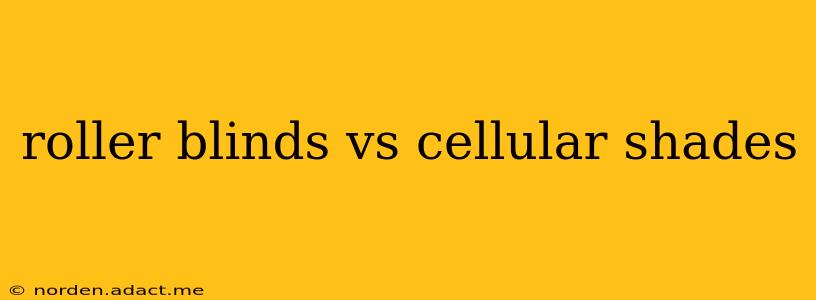Choosing the perfect window covering can feel overwhelming. Roller blinds and cellular shades are popular choices, each offering unique benefits. This comprehensive guide will delve into the key differences between roller blinds and cellular shades, helping you make an informed decision for your home. We'll explore their features, benefits, drawbacks, and ultimately, help you determine which option best suits your needs and budget.
What are Roller Blinds?
Roller blinds, also known as roll-up blinds, are a simple yet effective window covering. They consist of a single piece of fabric rolled onto a tube at the top of the window frame. The fabric is then unrolled to cover the window, providing privacy and light control. Roller blinds are available in a wide variety of fabrics, colors, and patterns, offering flexibility in design and style.
What are Cellular Shades?
Cellular shades, also known as honeycomb shades, are made of pleated fabric cells that trap air. This unique construction offers excellent insulation, helping to regulate temperature and reduce energy costs. They are also available in various colors and fabrics, and some even incorporate light-filtering or blackout features.
Roller Blinds vs. Cellular Shades: Key Differences
Here's a head-to-head comparison highlighting the key differences:
| Feature | Roller Blinds | Cellular Shades |
|---|---|---|
| Insulation | Minimal | Excellent (due to air pockets) |
| Light Control | Varies depending on fabric; sheer to blackout | Varies depending on fabric and cell size |
| Privacy | Varies depending on fabric opacity | Varies depending on fabric opacity |
| Cost | Generally less expensive | Generally more expensive |
| Maintenance | Relatively easy to clean | Can be more challenging to clean |
| Style | Wide range of fabrics, colors, and patterns | Wide range, but often more contemporary |
| Durability | Moderate; fabric can fade or tear over time | Generally more durable |
How Much Light Do Roller Blinds Block?
The amount of light blocked by roller blinds depends entirely on the fabric chosen. Sheer fabrics allow plenty of light to filter through, while blackout fabrics offer complete darkness. This makes them adaptable for various rooms and needs.
How Much Light Do Cellular Shades Block?
Similar to roller blinds, the light-blocking capabilities of cellular shades depend on the fabric. Light-filtering fabrics allow diffused light, while blackout cellular shades effectively block out almost all light.
Are Cellular Shades Better Than Roller Blinds for Insulation?
Yes, cellular shades are significantly better insulators than roller blinds. The air pockets within the honeycomb cells create a barrier against heat transfer, keeping your home warmer in winter and cooler in summer. This leads to potential energy savings on your heating and cooling bills.
Which are Easier to Clean: Roller Blinds or Cellular Shades?
Roller blinds are generally easier to clean. Many can simply be dusted or wiped down with a damp cloth. Cellular shades, with their intricate structure, can be more challenging to clean and may require more specialized cleaning methods.
Which is More Expensive: Roller Blinds or Cellular Shades?
Cellular shades typically cost more than roller blinds. This price difference is largely due to their superior insulation properties and more complex construction.
Which is Better for Noise Reduction?
Both roller blinds and cellular shades offer some level of noise reduction. However, cellular shades, due to their thicker fabric and air pockets, generally provide slightly better sound insulation.
Which Window Treatment is Best for My Home?
The best window treatment depends on your individual needs and preferences. Consider these factors:
- Budget: Roller blinds are a more budget-friendly option.
- Insulation: Cellular shades provide superior insulation.
- Light Control: Both offer options ranging from sheer to blackout.
- Privacy: Both offer varying levels of privacy depending on the fabric chosen.
- Style: Choose a style that complements your existing décor.
- Maintenance: Roller blinds are typically easier to maintain.
By carefully considering these factors, you can confidently select the window covering that best meets your needs and enhances your home's comfort and style.
